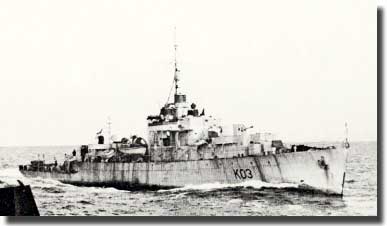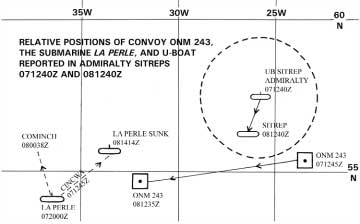|
French Submarine La Perle, who wants
friends that sink you?
The west bound Covoy ONM - 243, on the morning of the 8th. of July 1944 was about 800 kilometers south-east of Greenland. It was originally made up of 94 vessels, four of which missed the sailing date, and a further three had been detached, two for repairs, and the third being too slow to keep up with the convoy set speed. Amongst the remaining ships were the MAC Merchant Aircraft Carriers Empire MacCallum and Empire MacColl, a Swordfish aircraft from the former Carrier was on a routine sweep ahead of the convoy formation. The pilot, Lieutenant Francoix Otterveanger of the Royal Netherlands Navy, sighted a submarine on the surface sailing on a north easterly course and immediately assumed his sighting was a German U-Boat. In fact, it was the Free French Submarine La Perle . The senior officer leading the Canadian Escort Group C5, Acting Commander George Stephen, who had wide experience in his job, on receiving the Swordfish report was reputed to exclaim "Sink the bastard." ordering further aircraft from his two Merchant ship Carriers to join in the attack.
Bridge showing Commander George Stephen with other Officers In all, six more Swordfish joined Otterveanger, all flying clockwise around the submarine before carrying out a series of attacks. It was now one hour and five minutes, since the first sighting report, and the Escort Commander sent off a voice message to the MAC ships, Have aircraft been informed that submarine La Perle might be in our vicinity?" In Empire MacCallum, the poor air staff officer had no knowledge of La Perle, or what he was supposed to do about this latest message from the Escort Commander. Trying to play it safe, he attempted to reach the aircraft with a rather late warning "Look out for recognition signals in case the sub is friendly. If not, attack." With all the radio telephone traffic cluttering up the air waves, only one aircraft got this message, and he desperately asked for it to be repeated, just as the Netherlands pilot was making his first attacking run, one hour and fifteen minutes from the first sighting. From the conning tower of La Perle a series of L's were being flashed, this was the correct letter of identification for that day, Otterveager, not having heard the warning message about the possibility of a friendly boat being in the area concluded it was simply a ruse de guerre, and pressed on with his attack firing four pairs of rockets at his target. The other aircraft followed up with rocket attacks, the submarine now trying to defend itsself by light machine gun fire ( this of course seemed to the attacking planes merely to confirm the target was a German U-boat. ) Now Otterveager ordered an attack with two depth charges, and the friendly submarine was sunk in four minutes. only one Chief Petty Officer from a crew of 60 survived.
Submarine hulls of a boat similar to La Perle Why did the Escort Commander take so long to issue a belated
warning? There seems little doubt that HMCS Dunver, the ship in which SOE was embarked, would have received signals with information about La Perle and her Atlantic crossing. At the subsequent Board of Inquiry, Stephen's gave evidence that he had not seen the sailing orders of La Perle from St John's, and was unaware of the bombing restrictions in force until after the fatal attack. He however did acknowledge that the most recent signal received from Western Approaches did place La Perle close to the Swordfish sighting. He should have been more careful with his use of attacking aircraft.
HMCS Dunver Stephen's pleaded he was worried about a U-Boat that the Admiralty's
situation reports had placed to the north of his convoy, that had been sailing
in a SW direction over the three previous days. The findings of the Board of
Inquiry indicated this contention had all the hallmarks of special
pleading. From evidence at the Board of Inquiry it seems that Stephen's
impulsive order to sink the submarine was met with stunned silence. The
leading signalman in Dunver, John Seale, had developed appendicitus before the
ship returned to harbor, he was sent to hospital, did not give evidence to
the Inquiry, or the subsequent investigation into He reports saying to the Escort
Commander at the time " Sir, that may be the La Perle
" this recollection was received by Stephens with a non-commital
grunt. None of the other bridge personnel according to Searle said a word. It is
reported that George Stephen had a very dominating presence, the ship's officers
stood in awe of him, his men would do anything for him, but over the voyage he
refused to formally acknowledge any signals shown to him by a The air staff in the MAC ships were kept ignorant of La Perle's movements as Dunver did not keep them appraised of the situation reports.
It was certainly the responsibility of SOE to keep the convoy Commodore and his Vice Commodore up to date with all relevant naval signals, as the Merchant ships did not have the capabiltity to do this for themselves. Stephen at the Board of Inquiry said that these signals had been passed on, but they had not received any acknowledgements, nor were any transmissions logged, it seems a very slap dash approach by the ship's communication department, and of the overseeing of their methods by Stephen himself. Of course, all very convenient at any subsequent Inquiry, no way of checking up with what had reportedly been going on signalwise between the SOE's ship Dunver, the MAC ships or the convoy leaders ships. Rear Admiral Murray, C in C Canadian North West Atlantic, in his report to the Naval Secretary observed:
The Chief of Staff to Murray quickly acted to put in force the handling of allied submarines on independent passage to stop a similar accident happening again. A bit like "Closing the stable door after the horse has escaped." A new procedure for handling like situations in the future was approved just after midnight on the day the Inquiry had sat. Immediate Findings of Board of Inquiry. Commander Stephen was granted the benefit of the doubt, if not in a pursuasive way:
Some blame was cast on C in C Western Approaches:
Lieutenant Ottervaenger was totally exonerated for his part in the sinking of La Perle. Carrying the SOE aboard one of the Escort Ships. Investigation of Dunver's Communication
Department.
Admiral Murray passed this on to Commodore Taylor, Flag Officer Newfoundland, requiring him to pass this reprimand to the two officers concerned. Staff Officers at St John's were appalled at this
decision. In due course, Naval Headquarters took this advice and ordered two separate actions:
It was a remarkable and almost unique reversal of a Naval Board disciplinary measure, at last some justice appears to have been achieved. George Stephen was only confirmed in his Acting Commander rank after his demobiliization in July 1946. There is little doubt that the unfortunate La Perle episode put paid to further promotion, employment in the RCN, or indeed to an offer for a commission in the Permanent Naval Forces of his country. Conclusion. The charge: "Sheer incompetence, leading to the unfortunate sinking of the Free French Submarine La Perle." |




